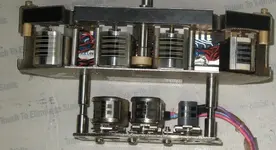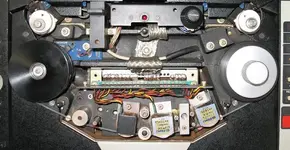evm1024
New member
I've managed to find enough parts to start working on the #2 Ampex ATR-100 parts machine. No photos yet....
I've spent the day working on this deck and thought to give a running monolog of the debug process.
The deck came missing a number of boards which I was able to get from eBay. The big ticket missing items was the tach roller and the capstan roller. I found 2 capstan rollers on eBay which I bought for less than $50 each. The first had the aluminum worn off the glass encoder disk (it forms part of a tach) and the second has the rubber turn to goo. Not all is lost. I have 2 cores now for rebuilding and the Goo'ed one can be used for testing. After cleaning and installing the 2 rollers I powered it up without any cards in it to check the power supply voltages. So far so good. No smoke or odd smells and the voltages are in the ballpark.
Next step was to install the reel servo, capstan serve and transport control boards. And then power it up again. Ah, there is an odor... Power off and start looking board by board. Smell, look, touch. A dual opamp on the reel servo board is hot and the 100 ohm series feed resistor for +12 is burnt.
Pull the opamp and put in a socket, replace the resistor and check some more local parts. The cause was a shorted tant cap. Replace both the tant on the +12 and on the -12.
The + and -12 on the reel servo board come from a voltage regulator circuit on the capstan servo board. The 13 volt zener diode is bad along with the regulation series pass transistor. No 13 volt zener diodes here so install a pot and replace the pass transistor with another one of lower power (all I had but should be more than enough). Test it out and set the voltage for 12 volts.
OK, power up again and no smoke or odors. Progress. Put some scratch tape on it and take the slack up. press the stop button. Odd, no click. Open up the control and discover that the stop microswitch is gone. Parts machine....
Ok use some alligator clips in place of the stop switch. Darn, the reel servo should activate and tension the tape. But nothing. Out comes the logic probe. Press stop (well touch the clips together) and follow the signal. All ok. Ah, the tension arm microswitch is not closed. Looks like a manual adjustment. OK, push the tension arm over manually and try to activate the reel servos again.
Excellent! Reel servos working. Tape is tensioned. Turn capstan manually and the reels move. very good, very good. Tape can shuttle back and forth.
OK, power up the scope. TIme to adjust the capstan tack. There is a glass disk with 1200 lines on it on the capstan and a grating with 2 photocells and LED on a set of small boards that shine through the disk. THe small boards can be moved in and out and rotated to get 2 quadrature signals from the disk. THis tells you the rotation direction and speed of the capstan. Scope them and move the boards for the strongest signal and correct phase relationship between them.
Looks good. Press play. The capstan turns!!! -------> Backwards.
Darn, so close. Check the motor connection. Keyed, no problem there. Time for dinner, eat, grab the manual and computer. Write this and then dig into the manual to try to find out what would make the motor turn backwards.
Good progress for the day. THis deck has 4 track 1/2" heads. I'm thinking of converting it to 1/4" 2 track but keeping the 4 track heads as well.
Regards, Ethan
I've spent the day working on this deck and thought to give a running monolog of the debug process.
The deck came missing a number of boards which I was able to get from eBay. The big ticket missing items was the tach roller and the capstan roller. I found 2 capstan rollers on eBay which I bought for less than $50 each. The first had the aluminum worn off the glass encoder disk (it forms part of a tach) and the second has the rubber turn to goo. Not all is lost. I have 2 cores now for rebuilding and the Goo'ed one can be used for testing. After cleaning and installing the 2 rollers I powered it up without any cards in it to check the power supply voltages. So far so good. No smoke or odd smells and the voltages are in the ballpark.
Next step was to install the reel servo, capstan serve and transport control boards. And then power it up again. Ah, there is an odor... Power off and start looking board by board. Smell, look, touch. A dual opamp on the reel servo board is hot and the 100 ohm series feed resistor for +12 is burnt.
Pull the opamp and put in a socket, replace the resistor and check some more local parts. The cause was a shorted tant cap. Replace both the tant on the +12 and on the -12.
The + and -12 on the reel servo board come from a voltage regulator circuit on the capstan servo board. The 13 volt zener diode is bad along with the regulation series pass transistor. No 13 volt zener diodes here so install a pot and replace the pass transistor with another one of lower power (all I had but should be more than enough). Test it out and set the voltage for 12 volts.
OK, power up again and no smoke or odors. Progress. Put some scratch tape on it and take the slack up. press the stop button. Odd, no click. Open up the control and discover that the stop microswitch is gone. Parts machine....
Ok use some alligator clips in place of the stop switch. Darn, the reel servo should activate and tension the tape. But nothing. Out comes the logic probe. Press stop (well touch the clips together) and follow the signal. All ok. Ah, the tension arm microswitch is not closed. Looks like a manual adjustment. OK, push the tension arm over manually and try to activate the reel servos again.
Excellent! Reel servos working. Tape is tensioned. Turn capstan manually and the reels move. very good, very good. Tape can shuttle back and forth.
OK, power up the scope. TIme to adjust the capstan tack. There is a glass disk with 1200 lines on it on the capstan and a grating with 2 photocells and LED on a set of small boards that shine through the disk. THe small boards can be moved in and out and rotated to get 2 quadrature signals from the disk. THis tells you the rotation direction and speed of the capstan. Scope them and move the boards for the strongest signal and correct phase relationship between them.
Looks good. Press play. The capstan turns!!! -------> Backwards.
Darn, so close. Check the motor connection. Keyed, no problem there. Time for dinner, eat, grab the manual and computer. Write this and then dig into the manual to try to find out what would make the motor turn backwards.
Good progress for the day. THis deck has 4 track 1/2" heads. I'm thinking of converting it to 1/4" 2 track but keeping the 4 track heads as well.
Regards, Ethan
Last edited:

 The bearings make noise and the supply reel motor is quite loud on REW or FF but it does work. Plays 15 and 30 ips, rew, ff, stop and even put it into record.
The bearings make noise and the supply reel motor is quite loud on REW or FF but it does work. Plays 15 and 30 ips, rew, ff, stop and even put it into record.




